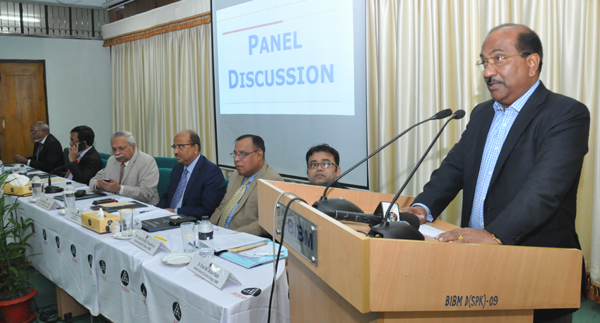

Banking Reforms Advisor of Bangladesh Bank (BB) S K Sur Chowdhury is addressing at a workshop in Dhaka on March 22, 2018. Photo: BIBM
Dhaka, Bangladesh (BBN) - Bangladesh’s foreign loan borrowers may face both interest rate and exchange risks following the recent rising trend of LIBOR (London Inter-Bank Offered Rate), according to the Bangladesh Institute of Bank Management (BIBM).
The foreign loans are significantly cost-effective for borrowers, but they may also create interest rate risk and foreign exchange risk, the BIBM said in a draft study report, released at a workshop in the capital on Thursday.
"As these loans are tagged with LIBOR, an increase in LIBOR will definitely create interest rate risk, and exactly this is happening in case of the Bangladeshi borrowers," it noted.
The private sector borrowers started borrowing significantly from foreign sources in 2013 when LIBOR was at the lowest level.
"But now the LIBOR rate has started to increase, which will definitely affect the borrowers in terms of higher interest payment,” it explained.
Apart from the interest rate risk, the borrowers are exposed to foreign exchange risk, as the exchange rate market also observed an appreciation of the US dollar, the BIBM noted.
Bangladesh Taka (BDT) depreciated by 3.54 per cent against the US dollar in a year at customer level to settle import payment obligations for different items.
The average exchange rate of US dollar rose to BDT 83.50 for the bills for collection (BC) selling on March 15 from BDT 80.65 on the same day of the previous calendar year, according to the market operators.
On the other hand, the US dollar was quoted at BDT 82.96 in the inter-bank foreign exchange (forex) market on March 15 last against BDT 79.55 a year before, they added.
In 2016, the central bank allowed private firms to borrow US$9.30 billion from foreign sources at low interest rates, ranging from around 5.0 per cent to 6.0 per cent, according to the report.
Bangladesh's private sector was allowed to receive foreign currency loans from overseas sources in 2008, primarily to import capital machinery for new industrial units and to modernise the existing units as well as for the sectors defined in the country's industrial policy.
Leading bankers and experts, however, suggested developing an effective benchmark interest rate along with broadening secondary bond market to popularise hedging mechanism for mitigating risks in future.
They also emphasised hedging, particularly for foreign currency loans, received from overseas sources by the corporate entities through offshore banking unit (OBU) operation of the banks, due to the recent upward trend of LIBOR.
The observations came during the discussion at the research workshop on 'Benefits and Potentials of Interest Rate Hedging: Bangladesh Perspective'.
"We're living in a world of uncertainty. Customers need to protect themselves from the volatility in exchange rates and interest rates. Appropriate hedging mechanisms are therefore needed," Banking Reforms Advisor of Bangladesh Bank (BB) S K Sur Chowdhury said while addressing as the chief guest of the workshop.
He also said hedging is a risk management strategy that is used to limit or offset probability of loss from fluctuations in prices of commodities, currencies or securities. Hedging is a part of risk management process that protects both the lender and the borrower from unwanted loss.
"….absence of a deep and broad secondary bond market is one of the main impediments of hedging risk. Short sale of securities is essential for some derivatives to be used as hedging tools. But regulation regarding short sale of securities has not been adapted yet,” Mr. Sur Chowdhury, also former deputy governor of BB, explained.
He also said exchange-traded derivative products are essential for hedging, but these are not yet available in the bourses of Bangladesh.
"It is time to make a plan for market development to introduce interest rate derivatives," said BIBM Director General (current charge) Dr. Shah Md. Ahsan Habib, while presenting the draft study report at the workshop.
He also said the banks are yet to enforce truly market-based interest rate practices, which are essential for identifying a benchmark rate.
"Should not the policymakers work for an effective market-based pricing system for identifying benchmark rate and variable lending operation in the country?"
On May 27, 2008, BB allowed hedging price risk of commodities to offset effects of volatility in the prices of essentials, including petroleum products, in the global market.
Under the existing provisions, hedging by using derivatives is commonly practiced by the parties, who seek to offset their risks by engaging in derivative transactions.
Md. Ali Hossain Prodhania, Managing Director (MD) of Bangladesh Krishi Bank (BKB), said financial literacy along with real benchmark interest rate is needed for interest rate hedging.
"Our market size is growing both in local and foreign exchange movements, while the interest rate is also significant that may cause potential loss to both the financial institutions and the corporate entities."
He also said the gain from hedging will be shared between financial institutions and businessmen to encourage corporate entities.
Mr. Prodhania, also Chairman of Technical Committee of Bangladesh Foreign Exchange Dealers' Association (BAFEDA), sought cooperation from all the stakeholders concerned to develop DIBOR (Dhaka Interbank Offered Rate) as an 'effective benchmark' rate of Bangladesh.
Among others, Supernumerary Professors of BIBM Helal Ahmed Chowdhury and Md. Yasin Ali, Dr. Barkat-e-Khuda, Dr. Muzaffer Ahmed Chair Professor of BIBM, Faruk Moinuddin Ahmed, MD and Chief Executive Officer (CEO) of Trust Bank Limited, and Syed Mohammad Bariqullah, faculty member of BIMB, also spoke on the occasion.
BBN/SSR/AD